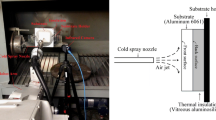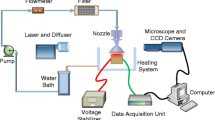Abstract
Experiments on evaporative spray cooling of flat heaters with plain and micro-porous coated surfaces were performed in this study. Micro-porous coated surfaces were made by using the DOM [Diamond particle, Omegabond 101, Methyl-Ethyl-Keton] coating method. In pure air-jet cooling, micro-porous coating did not show heat transfer improvement over plain surface. In spray cooling, however, three different flow patterns (complete wetting, evaporative wetting and dryout) were observed on both plain and micro-porous coated surfaces. The effects of various operating conditions, such as water flow rate, particle size, and coating thickness on the micro-porous coated surface were investigated. It was found that the level of surface wetting was an important factor in determining the performance of spray cooling. The level of surface wetting depended on the balance between the amount of liquid absorbed by capillary force over porosity and the amount of liquid evaporated. A micro-porous coated surface has a very high cooling capacity, especially in the evaporative wetting zone. The liquid flow rate and coating thickness are significant factors in the evaporative wetting zone, but are not in the complete wetting zone and the dryout zone.










Similar content being viewed by others
Abbreviations
- h :
-
Heat transfer coefficient (W/m2 °C)
- I :
-
Ampere (A)
- k :
-
Thermal conductivity (W/m °C)
- p :
-
Particle size (μm)
- Q :
-
Volume flow rate (ml/min)
- q″:
-
Heat flux (kW/m2)
- t :
-
Coating thickness (μm)
- T s :
-
Surrounding temperature (°C)
- T w :
-
Wall temperature (°C)
- V :
-
Voltages (V)
- ΔT :
-
Temperature difference between wall and surrounding (T w − T s)
- Φ:
-
Ni–Cr wire size (mm)
- w:
-
Wall
- s:
-
Surrounding
References
Cohen AB (1997) Thermal management of microeletronics in the 21st century. Electronic Packing Technology Conference, Singapore, pp 29–33
Kim JH, You SM, Choi SUS (2004) Evaporative spray cooling of plain and microporous coated surfaces. Int J Heat Mass Transf 47(16):3307–3315
Webb RL (1981) The evolution of enhanced surface geometries for nucleate boiling. Heat Transf Eng 2(3–4):46–69
Kurihari HM, Myers JE (1960) Effects of superheat and roughness on the boiling coefficients. AIChE J 6(1):83–91
Chang JY, You SM (1997) Boiling heat transfer phenomena from micro-porous and porous surfaces in saturated FC-72. Int J Heat Mass Transf 40(18):4437–4447
Choi KJ, Yao SC (1987) Mechanisms of film boiling heat transfer of normally impacting sprays. Int J Heat Mass Transf 30(2):311–318
Mudawar I, Valentine WS (1989) Determination of the local quench curve for spray-cooled metallic surfaces. J Heat Treat 7(2):107–121
Grissom WM, Wierum FA (1981) Liquid spray cooling of a heated surface. Int J Heat Mass Transf 24(2):261–271
Fujimoto H, Hatta N, Asakawa H, Hashimoto T (1997) Predictable modeling of heat transfer coefficient between spraying water and a hot surface above the leidenfrost temperature. ISIJ Int 37(5):492–497
Oliphant K, Webb BW, McQuay MQ (1998) An experimental comparison of liquid jet array and spray impingement cooling in the non-boiling regime. Exp Therm Fluid Sci 18(1):1–10
O’Connor JP, You SM (1995) A painting technique to enhance pool boiling heat transfer FC-72. ASME J Heat Transf 117(2):387–393
O’Connor JP, You SM, Price DC (1995) A dielectric surface coating technique to enhance boiling heat transfer from high power microelectronics. IEEE Trans CPMT A 18:656–663
Chang JY, You SM (1997) Enhanced boiling heat transfer from micro-porous surfaces: effects of a coating composition and method. Int J Heat Mass Transf 40(18):4449–4460
Lefebvre AH (1989) Atomization and sprays. Hemisphere Publishing Corporation, New York
Ester KA (1994) Critical heat flux in spray cooling and jet impingement cooling of small targets. Master Thesis, School of Mechanical Engineering, Purdue University
Kline SJ, McClintock FA (1953) Describing uncertainties in single-sample experiments. Mech Eng 75(1):3–12
Hsieh CC, Yao SC (2006) Evaporative heat transfer characteristics of a water spray on micro-structured silicon surfaces. Int J Heat Mass Transf 49(5–6):962–974
Acknowledgments
This work was jointly supported by a Korea University Grant and the Manpower Development Program of Energy and Resources (No. 2006-E-AP-HM-P-03-0000).
Author information
Authors and Affiliations
Corresponding author
Rights and permissions
About this article
Cite this article
Kim, Yh., Choi, C., Lee, Kj. et al. Experimental study of spray cooling performance on micro-porous coated surfaces. Heat Mass Transfer 45, 1285–1292 (2009). https://doi.org/10.1007/s00231-009-0503-z
Received:
Accepted:
Published:
Issue Date:
DOI: https://doi.org/10.1007/s00231-009-0503-z




